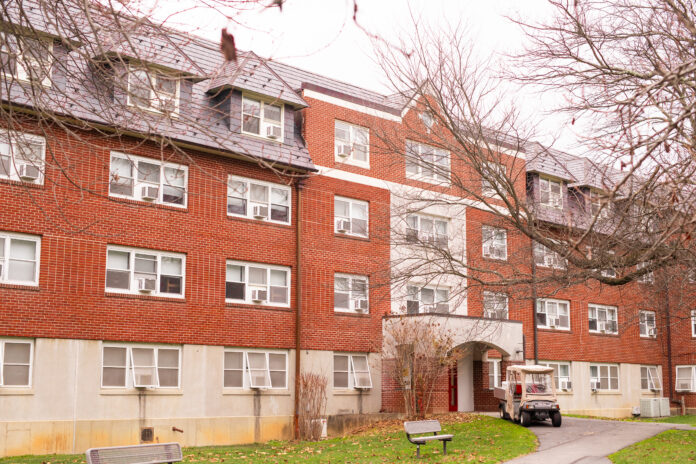An email sent out in the spring semester of 2023 sent waves through the Muhlenberg community as major changes to the housing system were announced to be implemented in the upcoming semester. These changes included the gender integration of Brown Hall, requiring all students (except commuters) to live on campus and the closing of Martin Luther (ML) Hall to the Muhlenberg community. ML specifically remains a mystery to many on campus as the building is completely separated from the Muhlenberg community. Students have been hypothesizing throughout the semester about what exactly is going on inside ML, such as Emma Schatzberg ‘25 who stated, “I heard that people are living there right now on the top floor, and people have seen people go in with animals and pets…I don’t know if anything is finalized now or if anything is going to happen.” Now that the first semester in which these changes were enforced is coming to an end, the Housing & Residence Life (HRL) department reveals how the proposed changes announced in February manifested themselves into real change, and students reflect on the outcome of these decisions on their current living situations.
Now that ML is utilized by outside entities other than Muhlenberg, Executive Director of College Life Operations Jane Schubert oversees the maintenance and operation of the building. Schubert and HRL responded together to a series of questions that clarify the details of ML’s current operation. They confirmed the idea stated in February that residents in ML consist of non-students. The building has been opened for local corporations and hospitals to house those in their internships, fellowships and residency assignment programs. One organization that houses its volunteers in ML is AmeriCorps, a government service agency that often visits the Lehigh Valley.
The wording in the response received from Schubert and HRL indicates which of these changes are expected to remain and which may be reconsidered in the future: “This temporary change for ML to be offline for students was made with the knowledge that there was ample housing on campus for the currently enrolled students. The permanent shift to Brown being an all gender building provides a more equitable balance of triples and singles across all genders.”
Schubert and HRL even confirmed that ML is likely to house Muhlenberg students once again with the projection of increased enrollment over the next three years. However, their response included a reiteration of the College’s reasoning for why these changes were an integral decision for Muhlenberg right now: “It also allows for students to select roommates of all genders throughout all housing. It allowed a higher percentage of first-year students to be housed in double rooms instead of triple rooms, which has benefitted students who are adjusting to living with a roommate for the first time. It does mean that it is likely there will be more sophomores in triple rooms for the next few years, but the triples in Brown Hall and East Hall are larger than many of the triples in Martin Luther, and sophomores can go into lottery planning for the possibility of a triple room in a way that is more difficult for first-year students.”
The administrators in HRL made these changes to the housing system to help first-year students adjust to the college experience and to make the housing system more equitable in terms of gender distribution. HRL also acknowledges that sophomores tend to get the short end of the stick with this system but rectifies this with the assertion that triples in Brown and East are spacious and sophomores have a better chance of acquiring them. This can remain a difficult situation if a student only has one roommate, meaning that they would receive a random roommate who they do not know and may not align with their living styles.
Many sophomores have expressed frustration with how the changes in housing have affected their class year in terms of living situations. Jade Gambino ‘26 said, “I felt like the closing of ML left very little room for students to live comfortably. Luckily for me, my current roommate had a low number, but if I were to have lived with my original roommate where my number was decent, I would have been stuck in a Benfer with a bunch of people I wouldn’t have known. ML was not favorable for students, but it was still a livable place for students and now it just remains empty and a waste of space. Students are anxious about housing because they could be stuck in an uncomfortable situation for the school to pay less money for housing. Also, the [change] of Brown was devastating because I personally planned to live in Brown again…I felt safest and most comfortable in a single sex environment, and I know others did as well. Brown being single sex was important for students to feel safe. I felt like the school only cared about costs instead of students. I currently don’t really like East that much because I don’t feel safe in a co-ed dorm environment.”
Another anonymous sophomore expressed similar ideas with the sentiment, “basically Brown used to feel more comfortable because it was a space for those who don’t identify as male, but now that it’s co-ed, the environment isn’t the same. That’s not to say residents have done anything intentionally, but it’s a shame that non-male identifying individuals don’t have a housing option anymore that makes them feel safer for whatever reason.”
The initial reactions of anger and disappointment expressed by students when these changes were first announced have simmered down throughout the semester. For this reason, HRL mentioned that they have not received concerns from the campus community at large relating to the closing of ML. They ensured that various benefits have resulted from these changes, including feelings of community in residential spaces resulting from the decrease in fullness of each hall. This has led to more attendance at floor and building programs “because students are not as spread out across the residential environments.”
The HRL department is also cognizant of the idea that sophomores are at a disadvantage with the current system. They said, “Sophomores who had to select triples in Brown or spaces in Benfer were understandably disappointed during the housing lottery. As we always do, we encouraged students to complete the waitlist form. Every student who was on the waitlist to leave Benfer was offered at least one other housing option from the waitlist. Some chose those options and some remained in Benfer. Some, but not all, students in triples were offered doubles on the waitlist. This was a common occurrence when Martin Luther was available as well, because there are a mix of doubles and triples in that building too. Interest in triples varies from year to year throughout housing.”
With the projection of increased enrollment within the next three years, it is possible that ML will once again be open for the use of Muhlenberg students. For the meantime, the building will remain something of a liminal place for Muhlenberg students as they reflect on their experiences with and without the building.
Samantha Tempkin ‘25 is a theatre and media & communication double major and is thrilled to be joining the Weekly’s staff as an Assistant News Editor! She is also the co-president of KPC, Muhlenberg’s K-Pop club. When she is not writing for the paper, Sam loves singing, dancing, listening to music, seeing Broadway shows, watching Marvel movies, and hanging out with friends!























